APS-C cameras used to have a few drawbacks compared to full frame cameras:
1. The smaller sensor produced noisier photos at high ISO and lacked dynamic range.
2. It is more difficult to produce a photo with shallow depth of field.
3. Due to the crop factor it was difficult to get a good quality ultra wide angle lens with a larger field of view than 120°
The introduction of the Fuji X-Pro 1 solved No. 1. for me right away. And while No. 2 is based on a law of optics I have found my way of dealing with it by changing my approach on taking those kind of images.
That left No. 3 still to be desired.
I have a Canon EF 15mm fisheye lens for my full frame camera, but when I connect it with an EOS-XF adapter to my X-Pro 1 the APS-C sensor size reduces the effective field of view to about 85° - or the equivalent FOV of a 23mm lens on a full frame camera. Fuji’s currently widest XF lens is the XF 14mm f2.8 with an effective field of view of 90° (equivalent FOV of a 21mm lens on a full frame camera) - and while this lens seems to be very impressive (it is my next review on the list), I had to look elsewhere to go much wider than 90°. My research led me to the Samyang 8mm f2.8 fisheye lens for the Fuji XF mount. The lens promises an effective field of view of 180°! Samyang is a Korean manufacturer and this particular lens is also branded as Rokinon, Bower and Walimex 8mm f2.8 lens and also available for different camera manufacturer mounts.
Throughout my photography career I have had mixed results with 3rd party lenses and ended up staying with the known “big” brands from the respective camera manufacturer. But due to the lack of alternatives and a reasonable street price of around EUR 300 in Europe or USD 300 in the US, I wanted to give the Samyang a try.
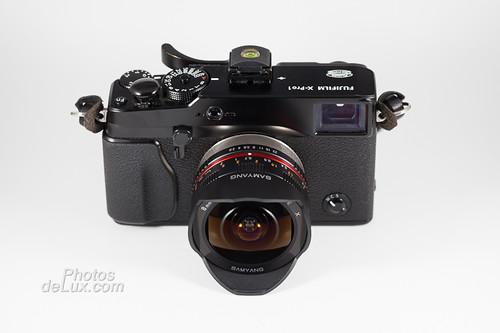
Samyang 8mm f2.8 XF attached to my Fuji X-Pro 1
After all, a fisheye lens is a specialty lens that should not be overused or you (and your audience) will soon get bored/annoyed by the effect it produces. And I can almost promise you that you will get tired of it after you see all the images in this post, too - so always use a fisheye lens wisely ;)
When the Samyang 8mm f2.8 lens arrived I was surprised! It is small yet very heavy. Compared to the Fuji XF 18mm f2 the Samyang is about the same size but a bit over twice as heavy (116g/4.1oz to 260g/9.2oz)! What did they use to build it – depleted uranium? But Fuji’s XF lenses are exceptionally well and light build and compared to the Canon EF 15mm f2.8 fisheye the Samyang is actually a bit lighter.
The Samyang’s aperture and focus rings are rather stiff even when compared to my legacy Olympus OM lenses. But this also gives me the feeling that this lens has a solid build quality and I will most likely get used to it over time. The lens is all manual and has no electronic intelligence that get’s passed on to the camera body. That has the big disadvantage that your Exif files will not contain any info about the lens and aperture. Luckily you can add a 8mm custom profile to the Fuji X-Pro 1 and if you activate it before you use the Samyang lens, the Exif will at least show 8mm. But the aperture will always read “f1”. And while you're in the Fuji's menus make sure that you activate the "shoot without lens" option, as the Fuji will not know that a lens is attached without electronic feedback from the lens.
Enough talk about the specs and feel, let’s see what this lens can do! I went out a few times and used this lens in situations where I think that a fisheye can work its magic.
All images were captured in RAW and processed and converted in LightRoom 4.3 with the "old" Adobe RAW converter. The new converter in version 4.4 could improve the image quality.
And as always click on the image to get the option for a bigger version in my Flickr stream.
Bad weather forced my to do most of my tests indoors so I started with some composition tests at the "Wandelhalle" in Hamburg's central station. On the first image I chose a vertical pano orientation as I wanted the clock as an eye catcher in the frame while giving the viewer an idea how the whole structure looked like:
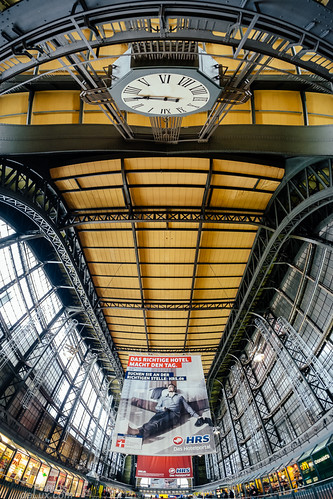
Vertical worked well here - 180° cramed in one photo :)
Just a few steps from the previous location I took this picture by pointing the camera up and aiming in horizontal orientation at the ceiling. Adding a stronger tone curve gives this image an even more dramatic look - looks a bit like an old factory:
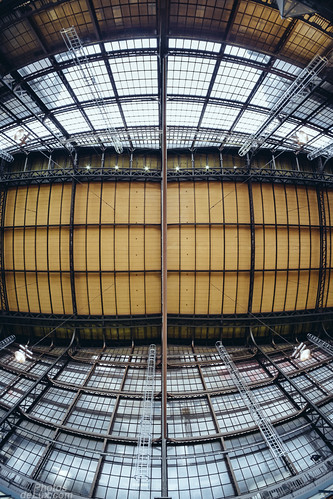
This angle of view created a totally different look of the same location
And finally I took an image of the station entrance pointing the lens straight up at the ceiling:
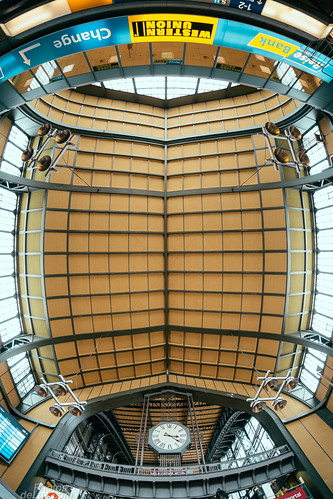
You need to take your time to align the framing carefully
After testing the versatility of this lens to create different looks in the same location, let's have a brief look at the sharpness in the next sample. I took this image in low light at f2.8 in a subway station and cut it close to a 2:1 aspect ratio to give it a panorama look. This is another advantage of having a 180° field of view - you get an instant one shot panorama :)
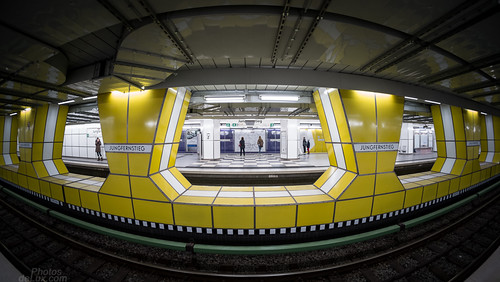
Cutting off some of the top and bottom of this frame creates a panorama look
Let's get closer to the center of the frame. Remember this is at f2.8 and ISO 800 and 1/30s exposure. There may be slight motion blur in people but overall this is pretty good:
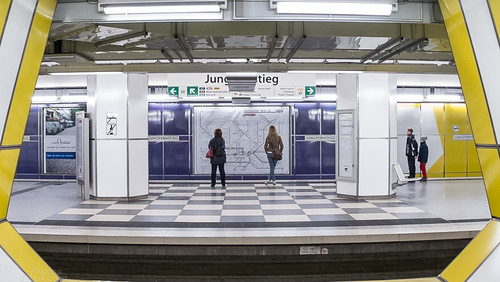
I am really happy with the results at f2.8 in this low light situation
Not wanting to turn this blog post into a pixel peeping competition let me just say this about sharpness, contrast and color rendition from my experience so far. Considering that it's a fisheye lens for a reasonable price I am astonished how well this lens does! At f2.8 it is perfectly usable and at f4-5.6 it leaves nothing for me to be desired in a fisheye lens. The edges are a bit softer the further you get towards the corners and there is some vignetting when shooting this lens wide open, but this should not be a surprise to anyone who has some experience with wide and ultra wide angle lenses.
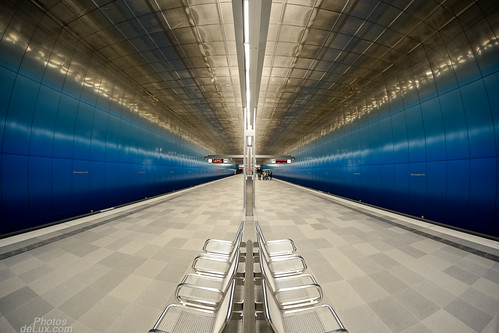
At 180° you get more info into your images than the human eyes can normally see (about 120° with peripheral vision)
At f5.6 the corners are very sharp for a fisheye lens. And if you set it to f5.6 and a focus distance of 2m (6ft) you get a sharp focus zone from about 0,5m (2ft) to infinity.
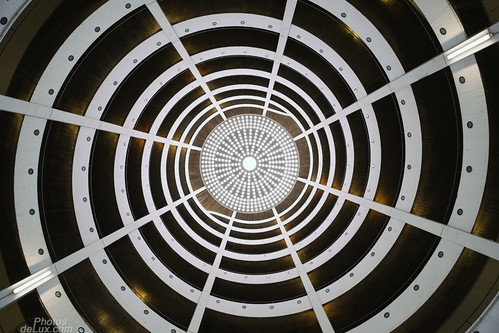
This is one of my favorite wide angle subjects shot at f5.6
At 180° field of view you will often have light sources, like the sun, shining directly into the lens. The Samyang 8mm f2.8 has a permanent lenshood. But that is just large enough not to show up in the frame. And the convex outward pointing front element of the lens is easily exposed directly into a light source. So inevitably flare becomes an issue. And as for most wide angle lenses the Samyang 8mm is not immune to flare. Depending on the angle the light enters and the aperture chosen (the higher the f-stop the stronger the flare and aperture blade diamonds can show up) the stronger the flare will be visible. Yet, in this sample image I only had to stamp out two spots to get rid of the most visible (unwanted) flare:

Shooting into the sun at f5.6 - I added a vignette in post
And it is a very similar situation with chromatic aberrations - only that they tend to be stronger when shooting at wide open aperture. The Samyang shows some chromatic aberrations in back light situations around fine structures, but it is very low and very easy to fix in LightRoom 4. The Canon EF 15mm fisheye on the other hand is a CA nightmare on my full frame DSLR!
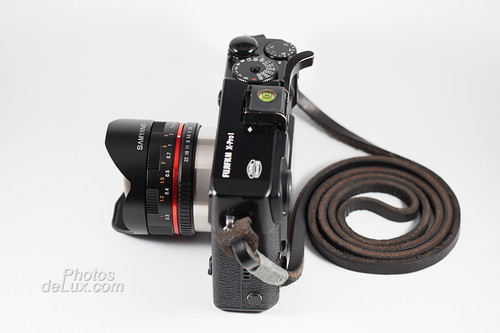
The Samyang lacks DOF markings on the lens and its shortness introduces problems
So far I am very positive about this lens. But there are also a few problems that I encountered during the past week of intensive use. For one this is a fully manual lens like we used to have them before AF was invented. And during that time it was common to add a depth of field scale to the lens. This way you could easily prefocus to a distance and an f-stop that would deliver a sufficiently large DOF for your intended use. The Samyang does not have such a DOF scale and IMHO the person responsible for this omission should not get any dessert in the Samyang cafeteria for at least one year ;)
Secondly, and this really turned into a challenge for me, the lens is too short. How can that be a bad thing? Well, when packing and transporting your gear it is a big advantage. But when you hold your camera in one hand and use the other hand to support the lens while operating the focus ring, you will most likely end up unintentionally capturing your fingers very often! For me as a right handed person the fingers from my left hand (holding the lens) appeared many times in the bottom right corner of the images!
I will have to find a different grip when using this lens on the Fuji X-Pro 1. Shooting and aligning a fisheye lens correctly is challenging enough that I don't have time to check the corners of the frame all the time and it might mess up my carefully composed framing...
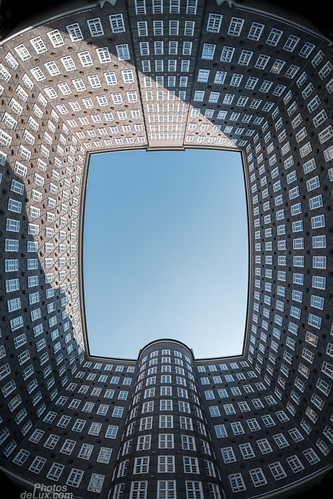
Perfect framing is essential for these kind of photos - better activate the "grid view" in the EVF
This brings me to my last and one of my favorite Samyang 8mm f2.8 image for this post - the new U4 Überseequartier subway station in the Hamburg HafenCity:
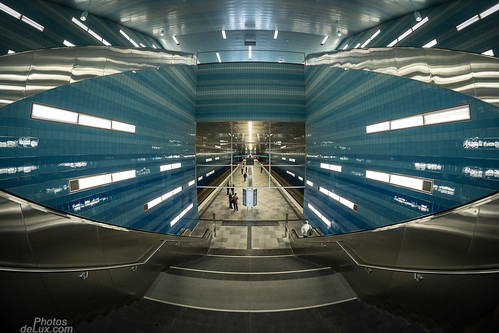
An 8mm fisheye lens is made for this location - U4 Überseequartier Hamburg
My conclusion:
Positive:
+ It's sharp at f2.8 and gets better up to f5.6 (especially corners)
+ It produces good color and contrast
+ It's solid build and small
+ Chromatic aberrations and flare are very controllable for a fisheye lens
+ Very reasonable price for what you get
Neutral:
o The aperture and focus ring are a bit stiff
o The lens is quite heavy for its size
o The amount of Vignetting appears to be normal for a fisheye lens
o Aperture is changed in 1/2 f-stops instead of 1/3 f-stops
Negative:
- There are no depth of field markings on the lens! Why not???
- No lens information (lens type, f-stop) is passed on to the camera (custom set it to 8mm in camera!)
- Attached to the X-Pro 1 the lens is very short and it is hard to hold (support) the lens without capturing part of your fingers in the corner of the frame.
- The minimum focus distance starts at 0.3m (1ft). At that distance a 8mm lens closeup shots doesn't look very close at all and it can't produce this special funny perspective that is unique to some UWA lenses.
At first I was a bit sceptical about buying a "new" third party lens for my Fuji X-Pro 1. But the fairly low price, lack of a Fuji equivalent focal length and the fact that this is not an every day lens made the risk of ordering it a bit more manageable.
After a week of intensive testing I am nothing short of impressed with the value that this lens offers and if you have been wanting a fisheye lens for your Fuji X-Mount camera, the Samyang 8mm f2.8 is certainly worth a closer look.
If you have any further questions leave a comment below or Twitter me @HamburgCam
And if you liked my post I am always happy if you spread the word and retweet, like or google +1 it :-)
